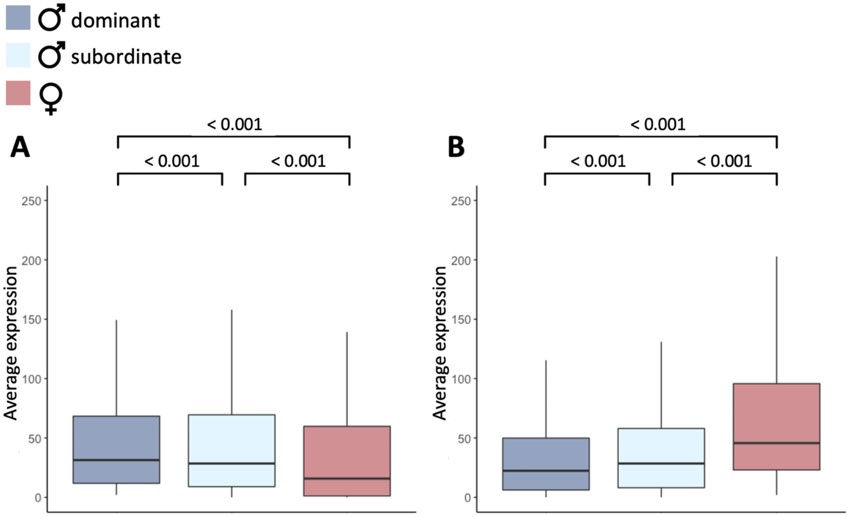Genomic analyses test whether alternative splicing contributes to sexual dimorphism.
It is no secret that male and female birds can look drastically different. Just think of the extravagant male birds-of-paradise compared to the dull females. It is interesting to contemplate how this extreme sexual dimorphism can develop given that males and females largely have the same genomes. One possible solution to this genomic conundrum is differential gene expression where males and females produce different amounts of certain genes that underlie particular traits. So, it is not about what you have, but how you use it. There has been a lot of research on the relationship between sex-specific gene expression and sexual dimorphism (see for example this review paper by Judith Mank), but other regulatory mechanisms have been largely overlooked. A recent paper in the journal Molecular Biology and Evolution took a closer look at one of these mechanisms: alternative splicing.
Mixing it up
Alternative splicing is a molecular mechanism that allows a single gene to code for multiple proteins. To understand this mechanism, we need to quickly recap the structure of a gene. As you might remember from high school biology, most genes are made up of exons and introns. An exon is a section in a gene that encodes part of the final messenger RNA (mRNA). Introns, on the other hand, are removed from the mRNA molecule and will not be expressed. In alternative splicing, these exons and introns are used in different combinations, giving rise to several protein variants (known as isoforms) that might have different functions.
Thea Rogers and her colleagues investigated whether alternative splicing might contribute to sexual dimorphism in birds. They studied gene expression patterns in three species: the Mallard (Anas platyrhynchos), the Turkey (Meleagris gallopavo) and the Helmeted Guineafowl (Numida meleagris). The results indicated that alternative splicing was common in all species, with an average of 21%, 17%, and 24% of the autosomal genes undergoing at least one splice event in the Mallard, Turkey, and Helmeted Guineafowl, respectively. But were there any sex-specific differences in splicing?

Turkey Phenotypes
More detailed analyses revealed that the patterns of alternative splicing varied between the sexes. Interestingly, the most genes with sex-specific splicing were found in the reproductive tissues (i.e. the testes and ovaries). The authors write that “this suggests that ovaries and testes are regulated by distinct sex-specific gene regulatory networks, and that sex-specific splice variants play a role in the construction of sex-specific genetic architecture.” However, these patterns only suggest a role for alternative splicing in sexual dimorphism. Therefore, the researchers took it one step further and compared splicing patterns in Turkeys with different degrees of male characteristics.
Turkeys come in two male phenotypes: dominant and subordinate birds. Dominant males are bigger and show more elaborate male features compared to the subordinate males. This results in a gradient of sexual dimorphism from females over subordinate males to dominant males. The researchers took advantage of this variation for some clever analyses. First, they classified the alternative isoforms as either male- or female-biased depending on whether they were expressed more highly in dominant males or females. Next, they looked at the expression of these isoforms in the subordinate males. This approach revealed that subordinate males express male-biased isoforms at lower levels and female-based isoforms at higher levels compared to dominant males. These patterns clearly support a role for alternative splicing in the development of sexual dimorphism.

It’s complicated
This study nicely shows that alternative splicing of certain genes plays a role in sexual dimorphism. The analyses focused on the big patterns, comparing hundreds of genes across species and tissues. A logical next step would be to zoom in on particular genes (or genetic networks) and unravel how they contribute to the differences between males and females. One thing is certain though, the genetic underpinnings of sexual dimorphism in birds are more complicated that we anticipated. Geneticist Steve Jones put it succintly: “Genetics has always turned out to be much more complicated than it seemed reasonable to imagine. Biology is not like physics. The more we know, the less it seems that there is one final explanation waiting to be discovered.” Exciting times to be a biologist!
References
Rogers, T. F., Palmer, D. H., & Wright, A. E. (2021). Sex-specific selection drives the evolution of alternative splicing in birds. Molecular Biology and Evolution, 38(2), 519-530.
Featured image: A pair of Mandarin Ducks (Aix galericulata) © Francis C. Franklin | Wikimedia Commons


[…] few weeks ago, I wrote about the molecular underpinnings of sexual dimorphism in birds (see this blog post). In most species where males and females look different, the dimorphism is very obvious. Think of […]